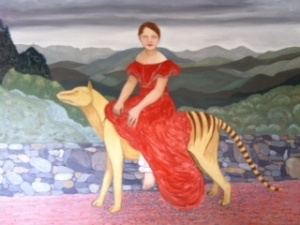
More updates on the painting I’m currently working on in my studio, The tiger bride, a largish oil on canvas of about 4′ x 5′. Like so many artworks, it is nothing like I had imagined it would be, and by the time it’s finished, I expected it will bear little resemblance to the original sketch.
I hadn’t actually intended to paint something so detailed, complex and well, labour intensive. Most of the time now I’m working with very small brushes, it feels like you are embroidering the surface of the canvas with a tiny needle. I had a couple of visual flashes the other day, the first was how I wanted the figure to look (kind of dewy and airbrushed, like fashion photography or a high kitsch religious icon) and the second was of the tiger (greyish silver, every hair gleaming and distinct, like a cross between natural history illustration and the painful sincerity of naive art).
The intricacies of the surface reflect my long standing fascinating with Persian miniatures, where patterning is used to show spatial depth, and every inch of the picture’s surface is laden (groaning even) with detail. I’m interested in what happens when you take this kind of visual language and use it on a large image. My desire is to create something that is strange and claustrophobic, almost hallucinogenic, but it may always fail and come across as extreme naffness: a Disney fairy tale stage set.
It’s that old thing about wanting to quote traditions without being subsumed by them. So I want the painting to reference the visual traditions of forms such as colonial art, naive painting and children’s book illustration but still be something separate and distinct. And with a darker edge: if it’s just a pretty image, then for me the thing doesn’t work. A subtext needs to be there, but neither obscure or obvious, balanced somewhere between the two extremes.
Another old idea, that of a trinity of figures. In this image I’ve just started sketching in the bride’s ‘handmaiden’s’, actually two Cape Barren Geese, indigenous to Tasmania. This is quietly humorous as Cape Barren Geese, from what I can remember from a camping trip on Maria Island, are cantankerous, stumpy and cross.
I dug up some more reference material for the Tasmanian Tiger. I’d been using an old black and white postcard, a photograph of the last couple of Tigers in captivity in Hobart Zoo, and a colour postcard of their skins. Then I found an early artist’s drawing that suggests that they had this line of white fur running underneath their jaws, down their chests, under the belly and extending through to a narrow line on the front of their rear haunches. I also found out that the tail was ‘stiff and unwaggable’, like a kangaroos, a piece of information I found oddly exciting. It was the word ‘unwaggable’ that did it.
More decorative elements have been added to this version; there’s some clematis on a bush to the left (from a book on Tasmanian flora). A proud notation states that they found ‘this magnificent display’ next to the East Derwent Highway. The flowers make this green foliage look even more like a screen, rather than a three dimensional form, I’m currently musing whether I like this or if it just looks wrong. A painting I worked on a couple of years ago, The Waterhole, featured a group of lollipop trees, each round circle of foliage operating as a series of flat, decorative overlapping shapes.
My sense is that this painting is nearly finished, although as I said earlier, I’m not sure what its final form will be. I’m still looking for some other element (perhaps the veil, perhaps the girl’s hair, perhaps a mask) that will make sense of all the painting’s disparate elements. Something that will make it potent. At the moment, there’s this feeling that it’s like a car body without an engine.
Finally, on the topic of how art has the potential to send one completely around the twist, check out this article from GQ. It just made me wanna get into the movie business!
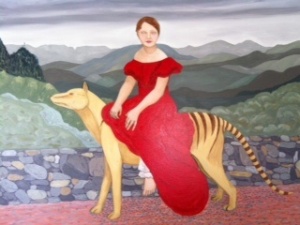
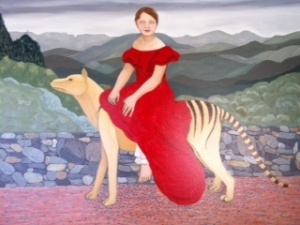
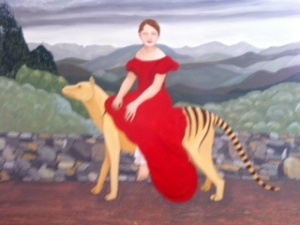
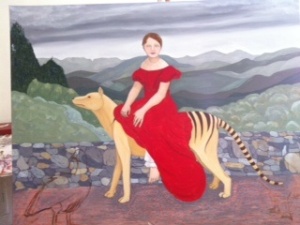
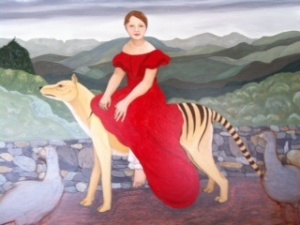
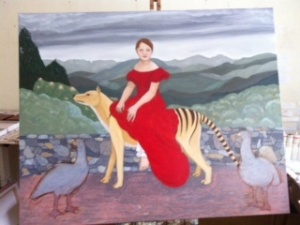
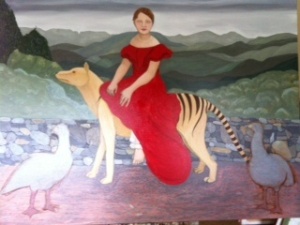
Hey Helen, really interesting to see this work coming along, also your thought process too. Love the trinity part 🙂 I have a theory called The Theory of Threes – but I lijke the idea of Trinity better. It has more resonance. See you 🙂
regards from Andrew Finnie